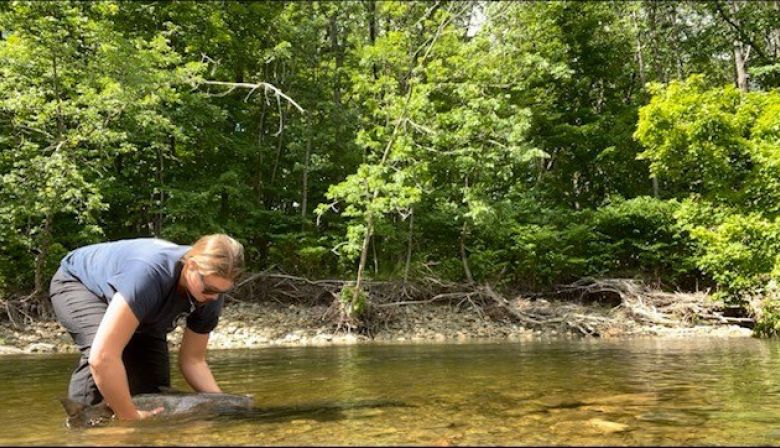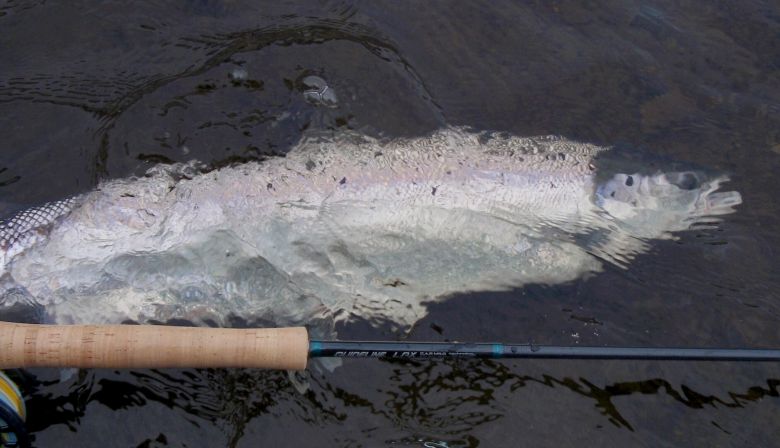
Subscribe & stay up-to-date with ASF

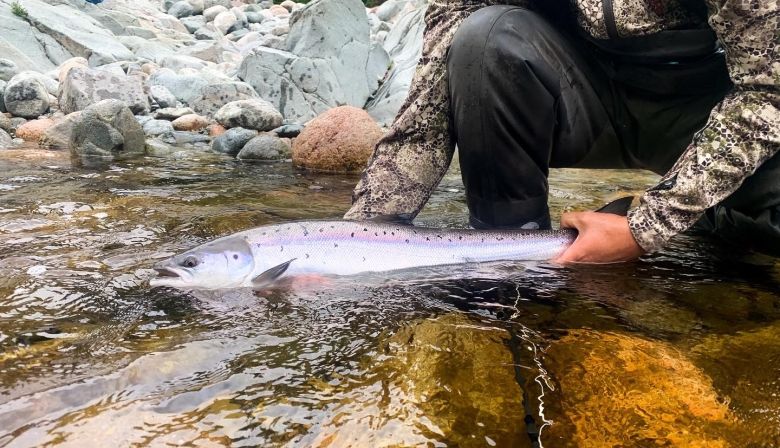
If you have a family adventure to share, please email us at rivernotes@asf.ca and be sure to tag us in all your social media posts.
Follow along with us on Instagram (@asf_salmon), Facebook and Twitter.

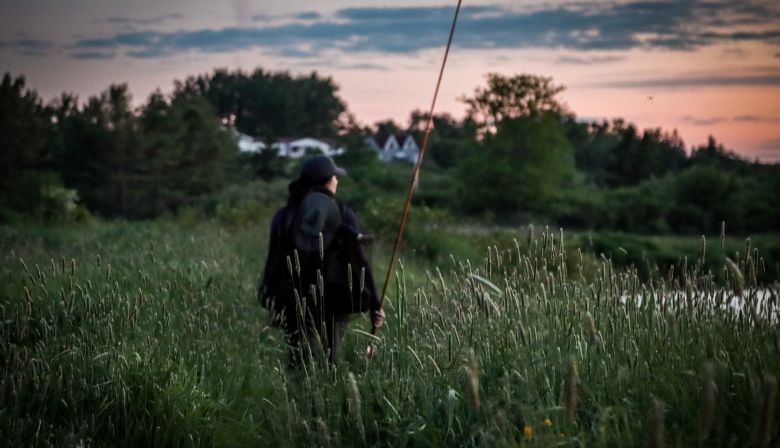

Si la tendance se maintient basé sur les saisons des dernières années, les niveaux d’eau plus bas traditionnels vont tenter les gens de circulé en véhicule dans les cours d’eau. Les rivières Pabos dans la région de Chandler sont très affectées par ce phénomène depuis trop longtemps. Vous trouverez ci-bas un lien d’un article publié en 2021 qui explique les conséquences de cette activité. Radio Canada
Rivière À Mars
Cliquer sur le lien ci-bas afin d’observer le premier saumon qui a franchi la passe migratoire en 2022. Facebook Video
Rivières Matapédia et Causapscal
La CGRMP indique un cumulatif en date du 26 juin, sur la Matapédia, 113 grands saumons graciés et 7 madeleineaux récoltés par rapport à 52 saumons graciés et 5 madeleineaux récoltés à pareille date en 2021.
Christophe Thiffault a fait la remise à l’eau de son premier saumon a vie dimanche dernier. Le poids du saumon fut estimé à 14, 5 kg. Bravo Christophe ! Photo – CGRMP – First ever salmon for Christophe Thiffault which he released on the Matapedia this past Sunday and estimated to weigh 32 lbs. Congrats!
Sur la Causapscal cumulativement au 26 juin, 112 saumons ont été graciés (un record de tous les temps) et 48 récoltés pour un total de 160. 31 saumons furent récoltés et 24 saumons graciés à la même date en 2021 pour un total de 55. La saison se termine le 15 juillet prochain.
Rivière Mitis
En date du 26 juin, les gestionnaires de la rivière nous partagent le fait que 167 grands saumons et 14 madeleineaux ont franchi le piège de capture. À ce jour, 7 remises à l’eau ont été enregistrées sur la Mitis et 1 sur la Mistigougèche.
Rivière Matane
Cumulativement au 26 juin, 230 saumons et 23 madeleineaux ont franchi la passe migratoire. Également, 30 saumons furent graciés et 1 madeleineau récolté.
Au 26 juin 2021, 223 poissons (196 saumons et 27 madeleineaux) étaient dénombrés.
Cliquez sur le lien ci-bas pour observer les derniers arrivés de la Matane: Facebook
Belle fin de journée sur la Rivière Bonaventure à la fosse Grassy – Photo Danyel Laquerre – Recent sunset at Grassy Pool on the Bonaventure.
Rivière Moisie
En date du 26 juin 2022, selon l’APRM, 54 saumons avaient été capturés sur la rivière Moisie, dont 19 remises à l’eau d’enregistrés. En comparaison, pour toute la saison 2021, 35 saumons ont été pêchés.
Rivière Rimouski
La saison, qui a débuté le 15 juin sur la Rimouski, se comporte très bien comme les autres rivières du bas St-Laurent. Au 26 juin, 53 grands saumons ont été graciés par les saumoniers et 1 petit saumon récolté.
À pareille date en 2021, 13 grands saumons avaient été remis à l’eau et 10 petits saumons récoltés.
Rivière York, Dartmouth et Saint-Jean
Cumulativement au 21 juin, la Zec Gaspé nous informe que les pêcheurs de la York ont graciés 172 saumons, 66 saumons sur la Dartmouth et 40 sur la Saint-Jean.

Charles Cusson, Director of Quebec Programs writes:
Very encouraging reports are being shared from all salmon regions indicating a very good migration to date along with very good angling conditions.
If the last few seasons are any indication, based on lower water levels as the season rolls along, many people will be tempted to drive vehicles in many water courses. An area that’s been affected severely for years now is the Pabos Rivers near Chandler. Please click on the link below to read an article written in 2021 detailing the effects and consequences of such activities. New cohabitation problems observed on the Gaspé rivers | Radio-Canada.ca
À Mars River
To observe the first salmon coming back in 2022, please click here!
Matapedia and Causapscal rivers
The CGRMP reports, as of June 26, on the Matapédia, 113 large salmon have been released and 7 grilse harvested compared to 52 salmon released and 5 grilse harvested cumulatively at the same date in 2021.
As for the Causapscal, 112 salmon are reported released (a record that keeps growing) and 48 harvested for a total of 136. To the same date in 2021, 31 salmon were harvested by anglers and 24 salmon released on for a total of 55. The season closes on July 15th.
Mitis River
As of June 26, river managers report 167 large salmon and 14 grilse have reached the capture trap. For the season at June 26, 7 salmon salmon have been released on the Mitis and 1 on its tributary, the Mistigougèche.
The 2022 run comparison to date is ahead of the result recorded on the same date in 2021.
Matane River
Cumulatively as of June 26, 253 fish were counted (230 large salmon and 23 grilse). 30 large salmon have been released to date along with 1 grilse harvested.
Compared to the same date in 2021, 233 fish (196 large salmon and 27 grilse) had been counted through the fishway.
Click here to see the latest batch of fish go through the fishway.
Moisie River
As of June 26, 2022, according to the APRM (Moisie River Protection Association), 54 salmon had been landed which includes 19 releases. In comparison, for the entire 2021 season when 35 salmon were landed for the entire season.
Rimouski River
The season, which began on June 15th is continues to perform like other rivers of the lower St. Lawrence region. As of June 26th, 53 large salmon have been released and 1 grilse harvested.
As of the same date in 2021, 13 large salmon had been released and 10 grilse harvested.
York, Dartmouth, and St-Jean Rivers
This extremely popular trio of rivers is also having a spectacular start to the season.
As of June 21, for the season, the Gaspé Zec is reporting good angling, on the York where anglers have released 172 salmon, on the Dartmouth 66 salmon and on the Saint-Jean, 40 salmon.
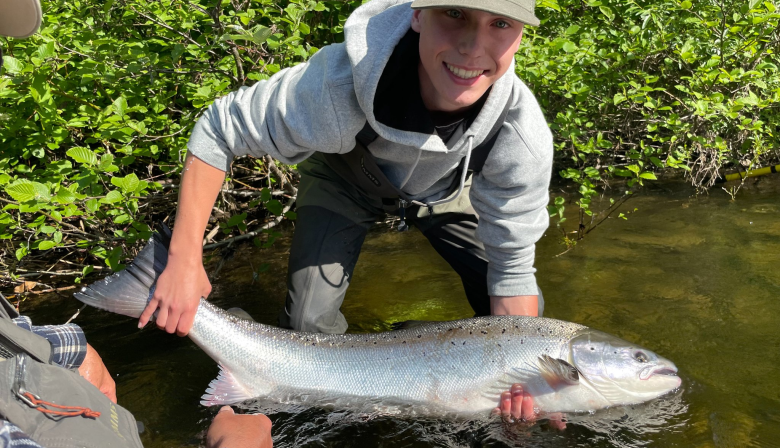
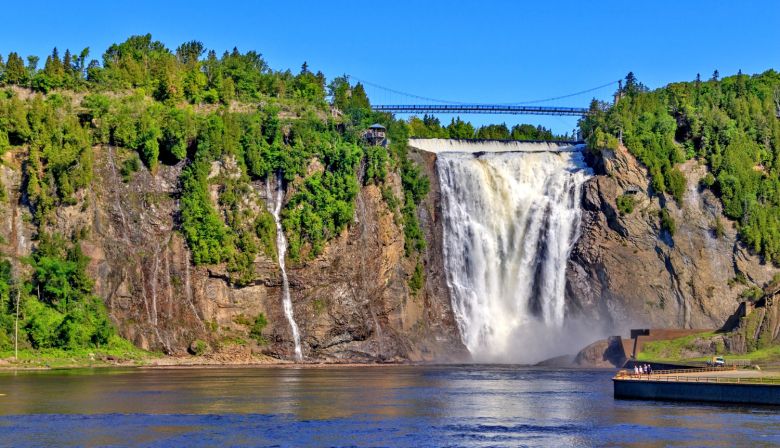

Traveling Angler Report
Jakob Lorefice writes: I have recently returned to my home in Nova Scotia after spending four weeks fishing the special rivers of Northern New Brunswick and Quebec. My trip began fishing the Restigouche and its tributaries. We had tremendous fishing, with fish upwards of 35 pounds being released from the middle of May to early June. Fortunately, I was able to hook and land one of these massive specimens while wading the Matapedia on June 13th.
The conditions were favourable, frequent rain and cold fronts led to high, cold water that lasted the whole duration of my stay. To see these giants up close, and to observe their long journey upriver to their spawning grounds will be forever etched in my memory.
My final days consisted of touring the Gaspé with my friend and fellow salmon angler Benjamin Frechette. We fished the York, and Dartmouth River. Despite the high discoloured water, we had good fishing. The last day of my trip, June 22, was spent in true Quebec fashion, fishing the Grand Cascapédia, otherwise known as the Land of the Giants. The water was quite high and made for an eventful day, we released 3 salmon, one of which was a true, but not so rare 30-pound Cascapédia Atlantic salmon.
To see these runs of large fish firsthand makes me hopeful for the future of the sport, while there are many things, we must change I believe we are headed in the right direction. Angling for these fish is not something to take for granted. We must fight to protect them and their habitat. As anglers something as simple as choosing to only fish in high, oxygenated, cold water can make a world of difference. Watching a wild Atlantic Salmon kick away energized and ready to return to its journey upriver is something that cannot be described in words, it must be experienced.
~
Je suis récemment retourné chez moi en Nouvelle-Écosse après avoir passé 4 semaines à pêcher dans les rivières spéciales du nord du Nouveau-Brunswick et du Québec. Mon voyage a commencé en pêchant la Restigouche et ses tributaires. De la mi-mai au début juin, nous avons eu une pêche formidable comprenant des saumons de plus de 35 livres relâchés. Heureusement, j’ai pu attraper et gracier un de ces spécimens exceptionnels en pêchant dans la Matapédia le 13 juin. Les conditions étaient favorables, des pluies fréquentes et des fronts froids ont entraîné des eaux hautes et froides, qui ont duré toute la durée de mon séjour. Voir ces géants de près et observer leur long voyage en amont jusqu’à leurs frayères restera à jamais gravé dans ma mémoire.
Ensuite, avec mon partenaire de pêche, Benjamin Fréchette, nous avons fait le tour de la Gaspésie. Nous avons pêché dans les rivières York et Dartmouth. Malgré les niveaux d’eau élevés et embrouillés, nous avons eu du succès.
Le dernier jour de mon voyage, le 22 juin, s’est passé à la mode québécoise, à pêcher la Cascapédia, autrement connu comme le Pays des Géants. Même si l’eau était assez haute et moins claire, nous avons relâché trois saumons, dont un vrai saumon de la classe Cascapédia de 30 livres.
Voir ces migrations de gros poissons me donne de l’espoir pour l’avenir de ce sport, même s’il y a plusieurs habitudes nous devons changer, je pense que nous allons dans la bonne direction. La pêche sportive pour ces poissons n’est pas quelque chose que nous pouvons prendre à la légère. Nous devons être vigilants pour les protéger ainsi que leur habitat. En tant que pêcheurs sportifs, quelque chose d’aussi simple que de choisir de ne pêcher que dans de l’eau froide et oxygénée peut faire toute la différence. Regarder un saumon atlantique sauvage repartir plein d’énergie et prêt à reprendre son voyage vers l’amont est quelque chose qui ne peut être décrit avec des mots, cela doit être vécu.
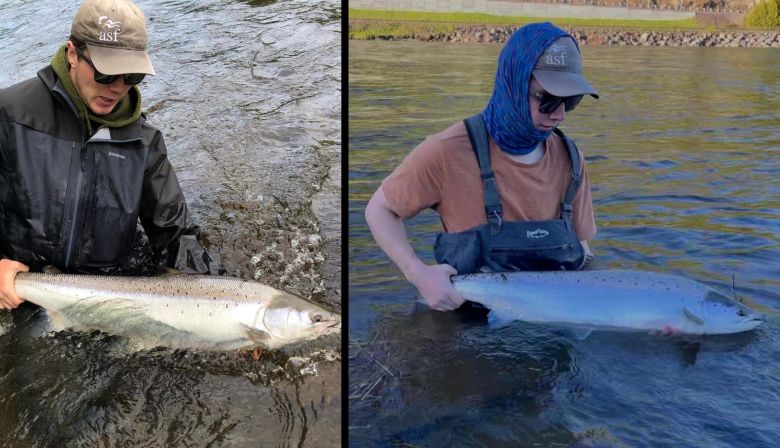
Christopher Minkoff, membre du comité organisateur du Banquet printanier de Montréal de la FSA a partagé certains faits saillants de son récent périple a la rivière Causapscal en compagnie de son partenaire d’affaire Christian Foisy.
C’est le meilleur début de saison depuis 20 ans » d’après les guides du secteur 2 de ce tributaire formidable de la Matapédia. « Les saumons semblaient être en santé et très fort après leur voyage en provenance de la côte ouest du Groenland ». « Ils étaient au rendez-vous et le niveau de la rivière était parfait.
Un de nos saumons démontrait des marques à la suite d’un très probable combat avec un phoque « Mais évidemment, Salar a remporté la palme ».
Montreal Dinner Fundraising Committee member, Christopher Minkoff shared a few notes from his recent trip to the Causapscal sector 2 with Christian Foisy:
The guides said this year was the best start to the season they have seen in the last 20 years, both in terms of number of fish and water conditions. The salmon were healthy and strong, except this big fish that had seal marks on both sides. I guess we can safely say Salar won!

As many of you know, salmon fishing around the Maritimes has been off to a great start. Late snowfalls and cool spring temperatures kept our rivers in good shape for the beginning of the season. We’re heading to the end of June now and the odd little patch of snow can still be found in deep, cool, shaded areas of remote sections in the Cape Breton Highlands; where monstrous snowdrifts towered during winter. Some solid rain has kept our rivers topped up and peat stained which beautifully contrasts against the vibrant green of the forest in June.
Most important to note is that good numbers of salmon have been returning to Margaree and North River here on the island. Some changes also behold — extreme flooding last November has made a mess in some areas. Sections of trail are gone, boulders the size of a car have shifted. Many strong footholds are now loose rock and banks are undercut. Just this week, a friend and I found an angler that was separated from his fishing partner. He wandered off the trail leaving him lost for a few hours. If you are unfamiliar with the woods and waterways around the Cape Breton Highlands, a guide is essential for your trip.
Visit Evan’s website at currentsflyfishing.com and follow him on Instagram @currentsflyfishing.

As is often the case, returns to some rivers are up while returns to other rivers are down. For instance, the returns to the Exploits River was 349 fish, which is down from 629 fish this time last year. Meanwhile, returns to Campbellton River are up from 69 fish in 2021 to 121 fish in 2022.
Of particular note are the returns to Harry’s River in Bay St. George as these appear to be down significantly from 577 fish in 2021, to only 35 fish in 2022. These numbers are deceiving since the 2021 numbers came from a counting facility on the lower section of Harry’s River (which is no longer in use), while the numbers for 2022 are coming from a counting facility near the community of Gallants, much further upstream.
It is notable that no fish have been counted yet from the four counting facilities in Labrador. Given the late spring experienced in Labrador this year this is not surprising, but we should expect to see some returns by next week.
Water levels on Bay St. George rivers were very low during the first half of the week (June 19-25), and during that time water temperatures were on the warm side. As a result, most anglers reported that fishing was very slow on all rivers in this region. In fact, one angler reported that he spent a week in the area and only hooked two fish. However, water levels on these rivers changed quickly following torrential rains mid-week, which led to flood conditions. This hampered fishing considerably. Water levels are just now starting to drop back. The rain brought a few fish, including some larger ones caught on Codroy River according to angler, Steve Walker.
Reports from a number of anglers who fished at Big Falls on the Upper Humber River early last week (including veteran angler Neil Smith) indicate that fishing was very good and there was a great mix of grilse and large salmon. However, heavy rain mid-week quickly created flood conditions and nearly brought angling to a stand still, except for a few die-hards. Two of these anglers were even swept off their feet into the river. Both were very lucky to make it back to shore. This should serve as a warning to all anglers too always practice extreme caution during such conditions by wearing a PFD and not taking unnecessary risks!
Water levels are still pretty high on most rivers on the Northern Peninsula, and water temperatures remain cold, as a result of late snow melt in the high country. Despite the high water levels, fish are being caught on Torrent River downstream of the fishway. Likewise, a few fish are also being caught on Big East River. Barb Genge, owner of the Tuckamore Lodge, reports that there are fish in Main Brook (aka Salmon Brook) but water levels are extremely high, and as a result angling is difficult.
In Southern Labrador, long time guide Lester Butt reports that water levels are currently high on the Forteau and Pinware Rivers and there has not been any sign of salmon at this time. He also reports that the capelin are late this year, and to date have still not showed up.
In Central Newfoundland, angling began to pick up on the Exploits River early last week, and since then good reports are coming from anglers, especially near Bishops Falls. Anglers are also reporting a few large fish being hooked along with the grilse. Water levels on this river are controlled for hydro purposes and as a result levels remain fairly constant. Currently, levels are ideal for angling, but the water temperature is starting to rise.
On the Gander River, Gander Bay Indian Band Chief, Calvin Francis, reports that as of early last week fish have been seen as far up stream as the TCH bridge near Glennwood. Now that water levels have begun to recede, reports indicate fishing success is also starting to pick up on the Gander River.
On the South Coast, heavy rain last week caused water levels on La Poile River and Grey River to reach flood conditions thus hampering angling. However, rivers to the east, like Conne River and Garnish River, only received moderate rain. Conne River remains closed to all angling due to low returns.
The Avalon Peninsula has only received intermittent rain during the past week. As a result, water levels are fair on some rivers while others, such as Rocky River, are currently experiencing low water conditions. Overall, fishing has been rather slow in this region to date.

National Indigenous Day & Fish Friends
This past week while conducting field work in Central Newfoundland, ASF’s Don Ivany & Kris Hunter met with Kim Thompson, Executive Director of the Environment Resources Management Association (ERMA) on the Exploits River. Kim has been doing excellent work with ERMA.
Don Ivany notes:
Among her many contributions, Kim has revitalized ASF’s ‘Fish Friends’ Program in a number of local schools. One participating school is Avoca Collegiate in Badger. On June 21st, Kris and I accompanied Kim to Badger to participate in the annual fry release by elementary students from Avoca Collegiate. The event was coordinated with National Indigenous Day and a ceremony hosted by members of the Qalipu First Nation marked this special occasion.
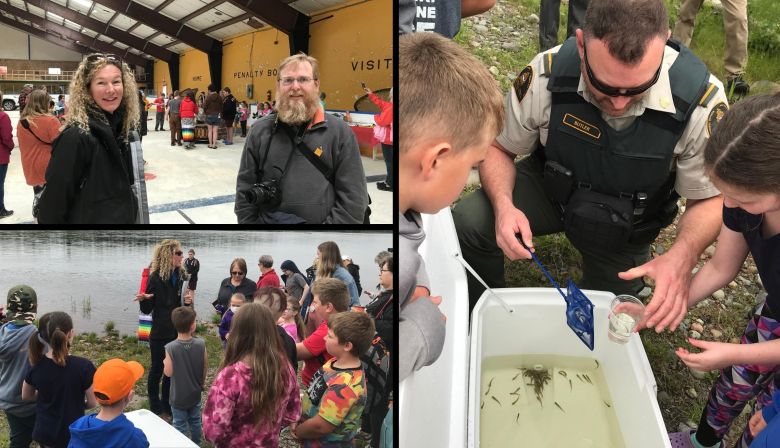
New Angling Line for up-to-date Salmon River Closures
The Department of Fisheries and Oceans advises anglers that there is a new DFO Angling Line with information on in-season salmon river closures in Newfoundland and Labrador. For up-to-date information on scheduled salmon rivers closed due to environmental conditions, call (709) 772-2045.
For general inquiries, anglers can continue to call: 1 (800) 782-3058. In-season river closures can also be located online HERE.
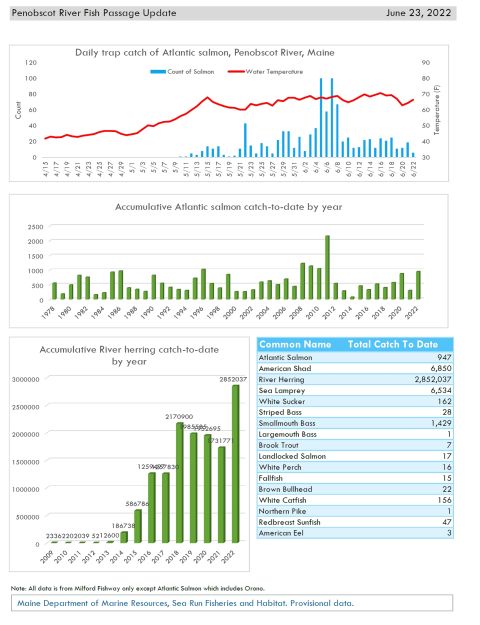
Walton’s Mill Dam Removal Project
Updates from ASF’s Maine Headwaters Project Manager, Maranda Nemeth follow:
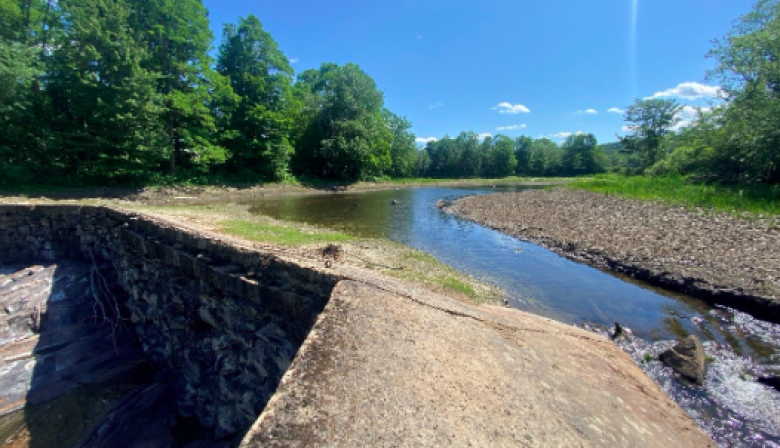
Walton’s Mill Dam along Temple Stream is pictured above. The impoundment has been drawn down 5 feet and the demolition is slated to begin mid-July. ASF has been working with partners since 2016 to complete this project. Over 54 miles of cold-stream habitat will be restored.

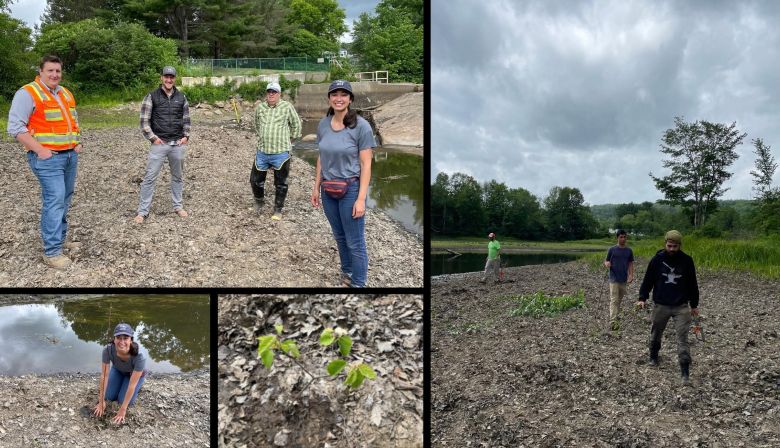
Over the past 2 months, the drawdown has been completed for the Walton’s Mill Dam Removal project along Temple Stream. The drawdown has been successful along the 1-mile stretch in allowing the native seed bank to flourish.
In the area closest to the dam, a layer of leaf litter has built up over several decades and is many inches thick. The native plants are unable to germinate as a result. To address this, ASF and our partners have planted over 75 live stakes to promote growth along the bank and prevent invasive species from taking hold.
The effort is already seeing results. Seen in one image is a live stake from 2 weeks ago already presenting new leaves. Establishing native vegetation is crucial to promoting wetland transition, bank stabilization, and future habitat to shade the stream.
Atlantic salmon are continuing to steadily be captured at the Lockwood fishlift and are transported to the Sandy River. Twelve new Atlantic salmon were captured since the last report. Today we have officially surpassed the largest run of Atlantic salmon caught at Lockwood fishlift since it has been operational (2006) with 66 salmon!!! The previous record was held in 2011 with 64 returning adult salmon. Most of the scales have been read to date and the run is ~60% wild, 40% hatchery (smolt stocked). Of the naturally reared salmon, 6% are grilse (1 sea-winter) and 94% are 2 sea-winter salmon. Of the hatchery origin fish, 70% are grilse (1 sea-winter), 30% are 2 sea-winters.
This year, returning multi sea-winter (MSW) adult salmon will be tagged with acoustic tags. The goal of this tagging study is to understand movement ecology and habitat use by natural-origin and hatchery salmon, thermal refuge use, and identification of spawning habitat. So far 17 returning MSW salmon have been tagged and released in the Sandy River.


Stock enhancement/beach seine project updates from DMR’s Craig King:
This week we’ve made a trip to Gouldsboro and Mount Desert Island to check fishways. Both locations showed post spawn adult (river herring) still leaving the systems.
Other projects included: preparing boats and gear to help tag both Atlantic and Short nose sturgeon next week. This project is working with the U.S. Navy to better monitor sturgeon movements in the lower Kennebec River.
We continue to monitor other fishways near our office more regularly and continue to wait on our first juvenile sample of 2022.
Lockwood fish lift (mainstem Kennebec) total catches for 2022 (as of 6/20):
River herring: 83,794
American shad: 5
Sea Lamprey: 7
Striped Bass: 33
Atlantic Salmon: 66*
* as of 6/23
Benton Falls (Sebasticook River) total catches for 2022 (as of 6/12):
River herring: 2,779,209
American shad: 3
Atlantic salmon: 4
Sea Lamprey: 61
Striped Bass: 0
Androscoggin River updates provided by DMR’s Mark Pasterczyk:
Here are the fish count numbers from Brunswick Fishway for the week of Monday 6/13/22 through Sunday 6/19/22.
American Eel: One eel came up in the lift one time this past week, it was small enough to swim through the 1” by 4” grating so it was left in the hopper and lowered back into the water.
American Shad: Week’s total of 76 passed upstream which brings the season total to 195 passed upstream.
Atlantic Salmon: Week’s total of 2 passed upstream which brings the season total to 9 passed upstream .
Sea Lamprey: Week’s total of 1 passed upstream which brings the season total to 370 passed upstream.
Smallmouth Bass: Week’s total of 11 passed upstream which brings the season total to 149 passed upstream.
Un-identified fry: Hundreds of un-identified fry were observed over the course of the week in the lifts and overhead tank. They were either lowered back into the water in the hopper or flushed down the upstream passage sluice pipe and/or tank drain.
Brunswick fish lift (mainstem Androscoggin) total catches for 2022 (as of 6/19):
River herring: 139,326
American shad: 195
Sea Lamprey: 370
Atlantic Salmon: 9
